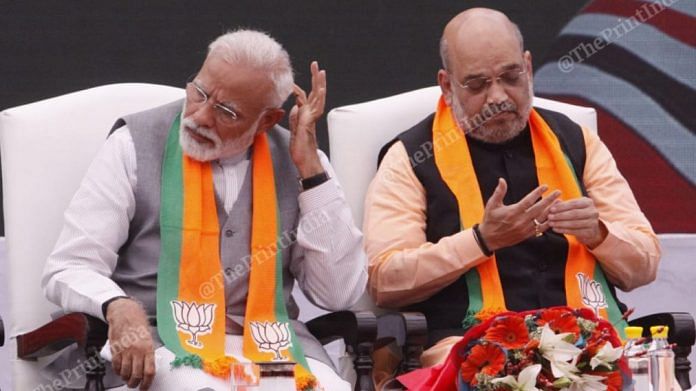New Delhi: As India debates the latest lynching of Tabrez Ansari in Jharkhand, it has been over a year since the Supreme Court urged Parliament to enact a law to deal with the rise in such crimes.
But several lynching incidents later, there has been no move to introduce the legislation. Over the year, however, at least 21 states, including Jharkhand, have filed their compliance reports in the apex court.
The Supreme Court had, on 17 July last year, called on Parliament to come up with a law to tackle the “horrendous acts of mobocracy”.
“Earnest action and concrete steps have to be taken to protect the citizens from the recurrent pattern of violence, which cannot be allowed to become the new normal. The state cannot turn a deaf ear to the growing rumblings of its people,” a bench comprising the then-Chief Justice of India, Dipak Misra, and Justices A.M. Khanwilkar and D.Y. Chandrachud had said. The judgment came in response to a contempt petition filed by activist Tehseen Poonawalla.
A week later, then-home minister Rajnath Singh said in Parliament that, if necessary, the government would enact a law against lynching.
BJP spokesperson and Supreme Court advocate Nalin Kohli told ThePrint that since Rajnath Singh’s statement, the country went to elections, which could explain why there’s no progress on the law one year on. “One will have to check whether any such need has been felt by the government, and whether data points towards the requirement for such a law,” he said.
Also read: Bihar encephalitis to lynchings to #MeToo – why Indians don’t take issues to the finish line
SC had issued a list of directions and guidelines
Apart from calling for a law, the Supreme Court had issued an ‘11-point prescription’ of directions and guidelines for the state governments to follow to curb lynchings.
The list included measures such as designating a senior police officer in each district for taking measures to prevent mob lynchings, registering FIRs under relevant provisions of law against persons who disseminate irresponsible and explosive messages, and preparing a lynching victim compensation scheme, among other things.
So far, 21 states, including Jharkhand, have filed affidavits in the apex court claiming to have complied with the guidelines. “These guidelines issued by the Supreme Court are legally binding, and all states need to comply with them,” Colin Gonsalves, senior Supreme Court advocate, told ThePrint.
In January 2019, Manipur became the only state in the country to enact an anti-lynching law. It, however, is yet to submit an affidavit saying it complies with the guidelines.
“A central law would ensure a certain consistency and standardisation in penalisation of the guilty, as well as compensation for the victim’s kin,” Poonawalla said. “If we leave it to the states to follow the guidelines, they will say we tried our best and that would be it.”
Govt appointed panel but ignored findings
On the direction of the Supreme Court, the Modi government appointed a panel to deliberate on the possibility of enacting an anti-lynching law. The panel included senior government officers and was headed by Union Home Secretary Rajiv Gauba. Its meetings were attended by advocate Anas Tanvir Siddiqui and Poonawalla.
“The government officials’ emphasis was solely on amending the existing provisions, and they had issues with the anti-lynching law we proposed,” Siddiqui told ThePrint. “They were unnecessarily nitpicking aspects of our proposal that would hold police officers and IAS officers accountable.”
The panel submitted its report to a Group of Ministers headed by Rajnath Singh in August 2018.
“The report lies in cold-storage as there has been no progress on it since it was submitted,” Siddiqui said. “Moreover, we were never supplied with a copy of that report, so we don’t know if our proposals had even been incorporated.”
Sources in the home ministry said there is no official update on the status of the report and if it is being acted upon.
Jharkhand case
In the Jharkhand lynching case, two police personnel have been suspended for ‘insensitive handling’ and 11 people arrested. The incident became public when a gruesome video of 24-year-old Tabrez being tied to an electric pole and beaten up on suspicion of being a thief was circulated.
Prime Minister Narendra Modi Wednesday said he is pained by the Jharkhand lynching case, but added, “none of us have the right to insult the state of Jharkhand”.
One of the guidelines in the 11-point prescription issued by the Supreme Court was that the state governments shall “immediately identify districts, sub-divisions and villages where instances of lynching and mob violence have been reported in the recent past”.
But the Centre Tuesday told Parliament that the National Crime Records Bureau (NCRB) does not maintain specific data on lynching incidents in the country.
Poonawalla said unless there is a central law, all government authorities will follow their statements condemning lynchings with a ‘but’. “‘He was lynched but he was a thief’, or ‘he was lynched but we shouldn’t tarnish the state’s image’ — this is the kind of response we should be wary of,” he said.
Also read: A 91-year-old law is making a comeback in India due to lynchings and WhatsApp forwards



